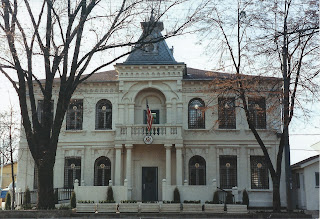 |
| Embassy building, before the renovation |
Setting up 12 new embassies at the same time was a large undertaking for the Department's Foreign Building Office (FBO). The name of the office has changed since then to Overseas Building Operations (OBO), but the name change wouldn't change the scope of the challenge. OBO normally plans to build no more than 4 to 6 new office buildings in year, and the projects are queued up years in advance. OBO had to take a different approach to transform the new embassies into functional buildings. A special coordinator was appointed, someone with real estate experience, although I cannot remember his name, likely because his choices weren't all that satisfactory and his assumptions were far off.
 |
| Second Corps of Engineers Dave |
His approach was to fly into each newly independent country and look for properties that could function for the next five years as temporary embassies. At the same time, he looked for potential residences for ambassadors and possible annex buildings if no building large enough to accommodate a full embassy could be found. And then he flew out, often on the same day. In Chişinău he was shown three buildings adjacent to one another. The Moldovans thought he would accept one of the three: a partially constructed brick house, an old and very typical eastern European two-story building with holes in all surfaces, and a larger non-descript one-story building. With no further research, he accepted all three. He thought the first could be the ambassador's residence, the second, the embassy, and the third, the consular section. But none of the buildings were really ready to be occupied, even though we were occupying the middle of the three by the time I arrived.
The next step for the 12 new embassies was for the buildings to be renovated and modified to permit the unique functions that are critical to embassies. OBO didn't have enough project managers on staff to manage the construction projects. Instead of increasing their staff, OBO contracted with the Army Corps of Engineers to manage the projects. And instead of fixed price construction projects, they solicited bids for cost-plus construction. The winning company was Fluor Daniel.
 |
Tom, construction manager for
Fluor Daniel |
The first Corps of Engineers project manager was Dave. The first Fluor Daniel construction manager was Tom. They arrived in Chişinău just before Thanksgiving to get the site mobilized. For Tom that meant hiring local staff to do all the work that didn't require cleared American staff. Earlier Fluor Daniel had sent one of their staff, a naturalized American of Moldovan origin, who contacted his childhood friends. Many of them became Fluor Daniel's staff in Moldova.
The reason OBO went with cost-plus contracts was as an incentive to get bidders so that the work could begin quickly, especially as the extent of the work wouldn't be clear until the demolition began. The disadvantage of cost-plus contracts was it was diffiicult to develop a firm the schedule. The work kept being delayed. The start was delayed. The projected completion date passed. Dave wanted out because he had another job to go to. The Corps of Engineers sent a replacement, another Dave. Tom also wanted out because he had been offered a very good opportunity managing the construction of a new ride at Disneyland. Fluor Daniel decided to try managing the projects in both Kyiv and Chişinău with the staff in Kyiv.
 |
Consular Section containers, the temporary buildings
erected by Fluor Daniel during the project |
A few months passed and OBO had had enough. The contracts with both the Corps of Engineers and Fluor Daniel were terminated and OBO sent Ertan, one of their staff members, to serve as the project manager, the construction manager, and the representative for OBO's interests, a near impossible task. Nonetheless, the project was eventually completed.
 |
Alexander, "Z-man", at his desk in the management section
in the former Fluor Daniel offices |
During the construction, most of the staff worked from the non-descript building next door. The plan was to renovate that building later, using local workers since the requirements were simpler. In the meantime, one end of that building served as a kitchen serving breakfast and lunch for the staff and the rest of the building housed a few offices and storage space. After a thorough examination of the unfinished house on the other side of the embassy building, OBO determined it wasn't safe to be completed. It was demolished to make room for staff housing instead. Fluor Daniel had erected a series of temporary offices on the compound behind that house during the project. When they left, we used them for the consular and
management sections. OBO wanted them demolished, too, in order to build nine townhouses for staff housing. The Moldovans thought the design of the townhouses was ugly because they were unlike anything else in Moldova. And when we finally took the measurements on the property, we realized that the front doors of the townhouses would be less than four feet from the embassy building, barely enough room to open the door. We didn't think it would be possible to get furniture into the townhouses with the small space between the buildings. The ambassador made the difficult decision to turn down the townhouses that were ready to be shipped as modular units.
 |
| U.S. Embassy, Chişinău, Moldova, after renovation |
It is now 20 years after the work done to make the temporary embassy building function. The expectation was that a new purpose-built embassy with the required setbacks for security would be built within the next five years. Instead, that original building is still functioning as the U.S. embassy in Moldova.






Sandra, thank you for the post. I didn't know all that history behind the Embassy building. Also, great pictures, wish I had pics from these times.
ReplyDelete